Reporting in the wake of Christmas remains spotty, but this fog of war was anticipated, and we must do what we can with what we do know. Mostly, what we’ve learned reinforces the picture outlined in Post #9, with reduced severity. Also with reduced generation time which we confirmed a bit via a study from South Korea.
I’ve also written up Omicron: My Current Model which gives the ‘here’s where we are at’ takeaways and news you can most practically use.
Denmark
Denmark’s reporting is usually excellent, but they’ve taken a few days off for Christmas and I don’t see new data even now, so nothing new to report on that front.
Hospitalizations continue to come in lower than expected (WaPo).
More important, hospitalizations have come in — so far — on the very low end of what was projected. A week ago, Denmark’s government science institute said daily new coronavirus hospital admissions could range between 120 and 250 patients by Christmas Eve. In recent days, daily admissions have hung around 125.
That’s not a big range, only varying by a factor of two. It reflects a kind of overconfidence – we have large uncertainty over true case counts and over severity on multiple fronts. We have known cases increasing by a factor of three or four depending on how you count lag, real cases doubtless up far more than that, yet hospitalizations only up about 50%, and still solidly below the United States.
The UK’s hospitalization numbers here are less promising, because given the delays in reporting plus lag in events, we still don’t have much information.

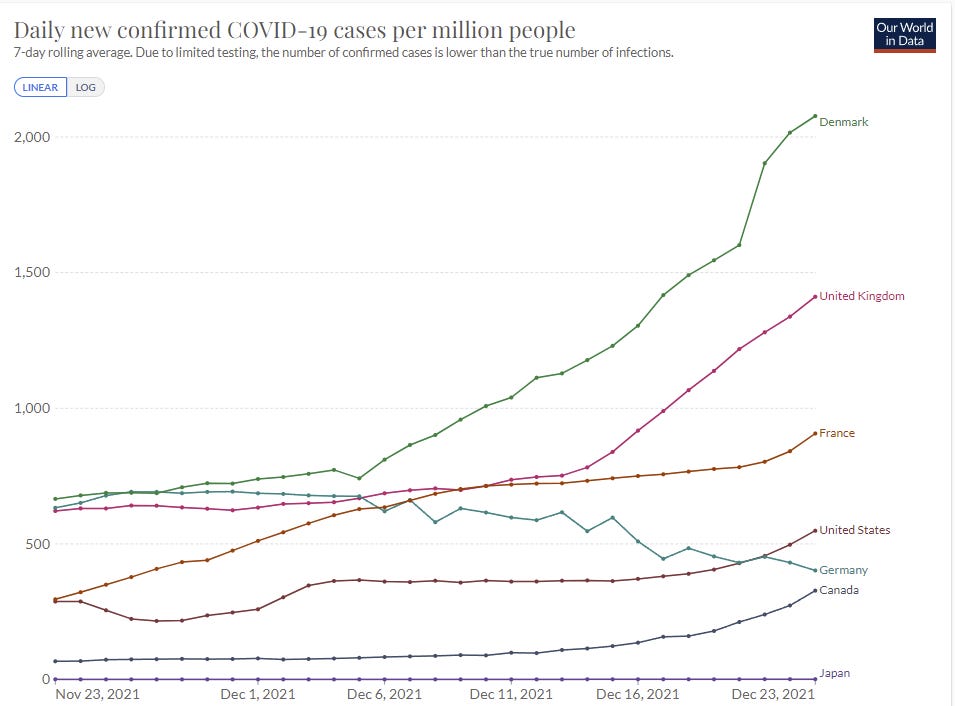
By Thursday data should have caught up, and we’ll have a strong data point on the severity level of Omicron. We won’t know if cases peaked or not, because of the holidays, unless the numbers kept going up in spite of the holidays.
United Kingdom
Looks like cases continue to rise, but holidays again make it very difficult to be certain.
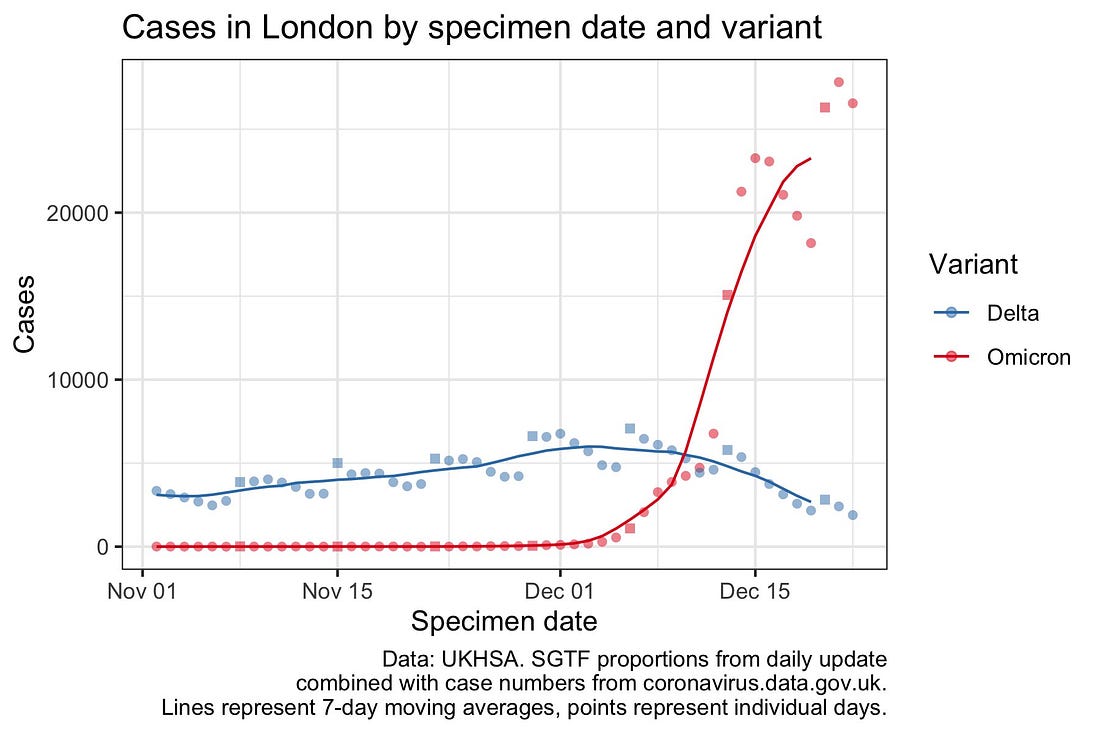
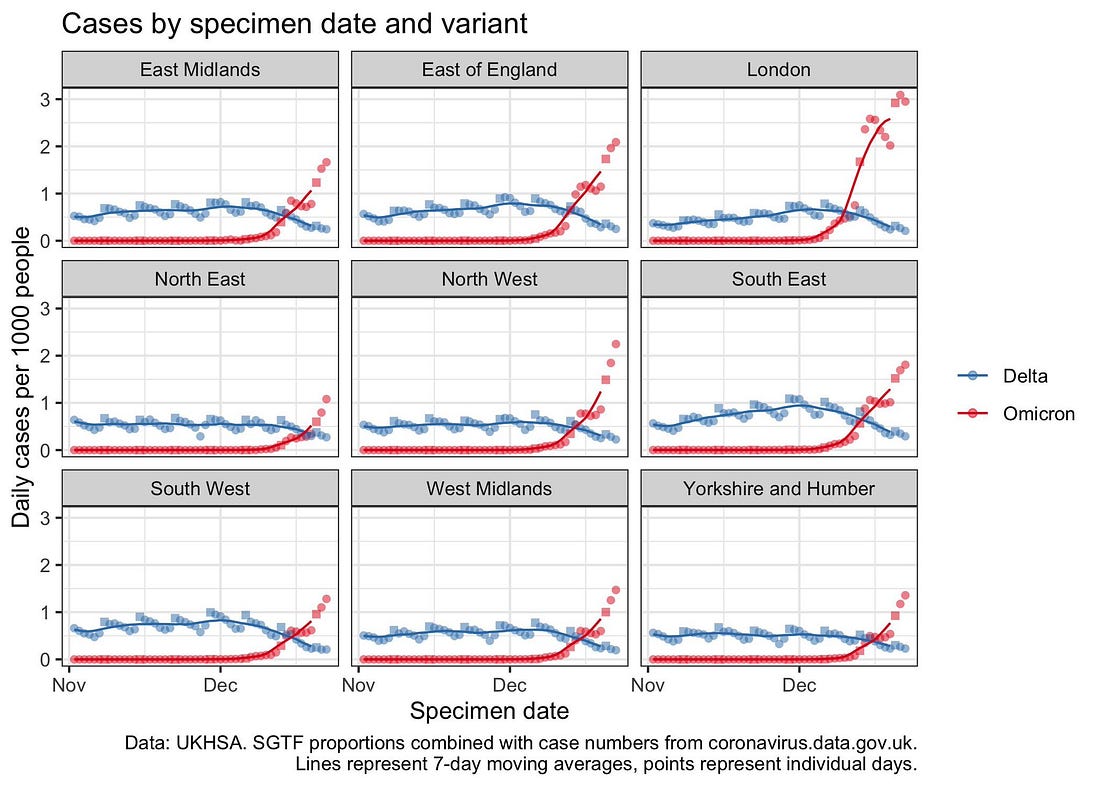

The temporary drop in testing followed by a return to trendline indicates to me that it was a temporary blip. It may have been reluctance to test, or reduced testing capacity, before the holidays. It may have been behavior change in advance of the holidays. Either way, records are once again being set.
Another data source and perspective.
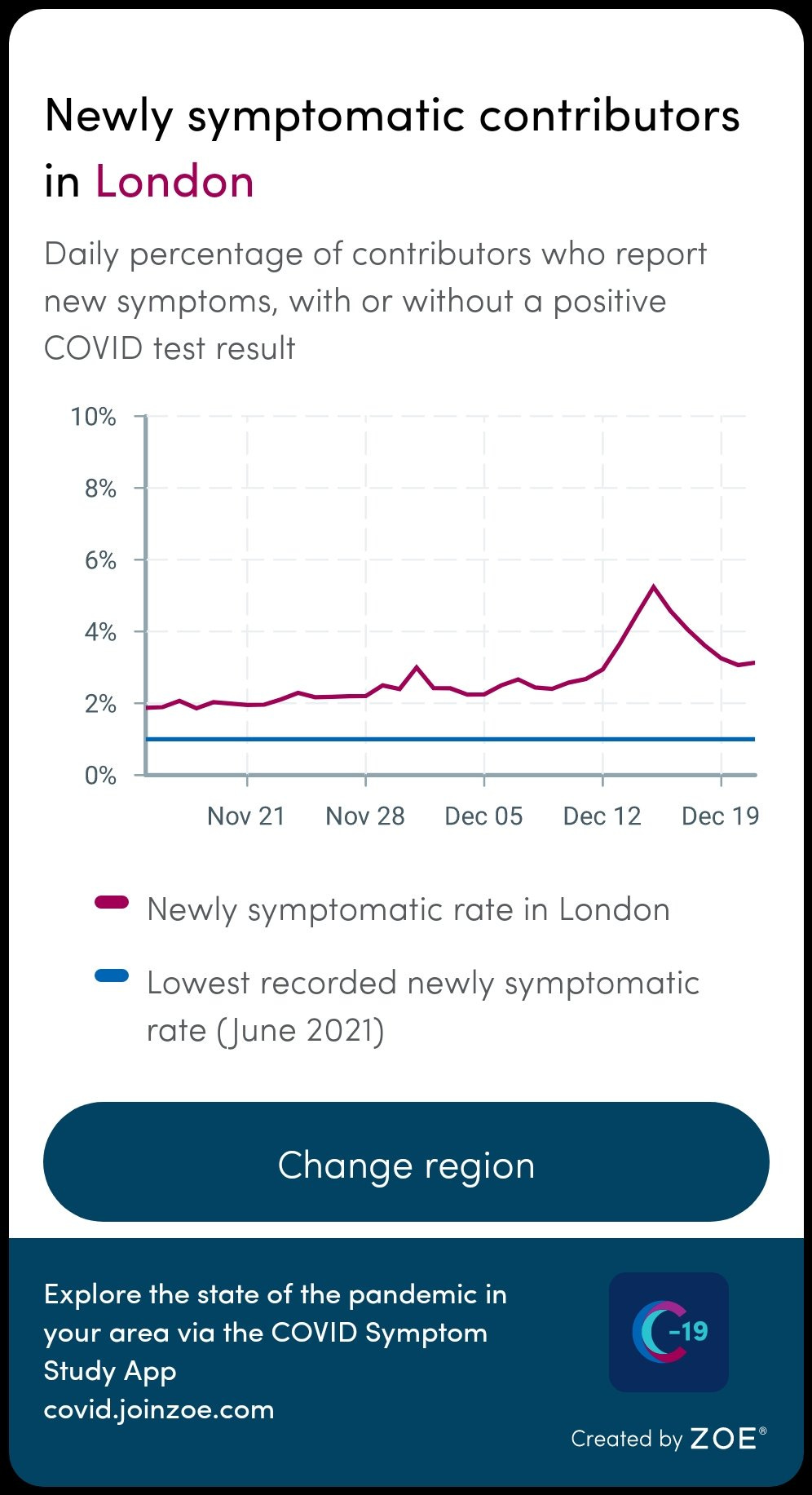
There’s no way we had this kind of decline that quickly given subsequent data. The only plausible interpretation here is that people stopped reporting.
Another estimate has 9.5% of Londoners Covid-19 positive on Christmas Eve, which seems plausible to me. (EDIT: I believe that the y-axis is labeled in error, and this is indeed 9.5% rather than 0.95%. If it is 0.95%, I defy the data, that number doesn’t make sense.)

Thread on UK hospital situation. Important questions here so quoting in full for those interested.

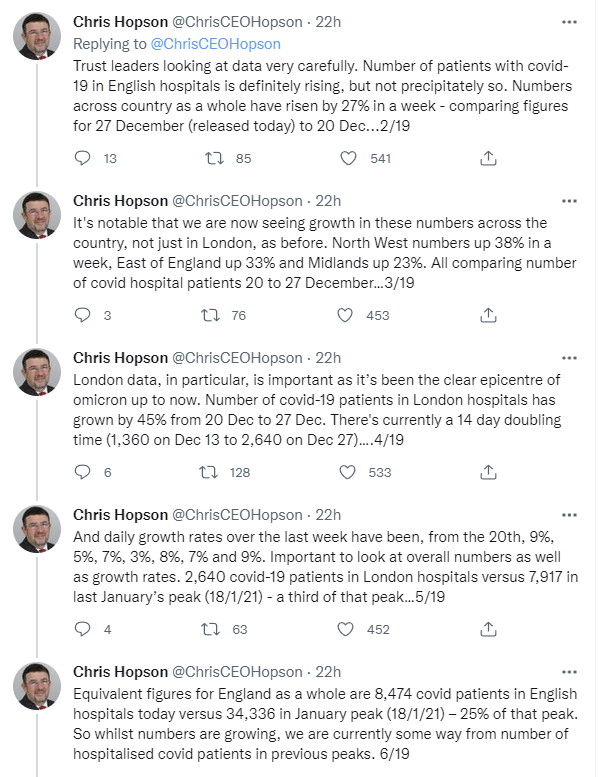
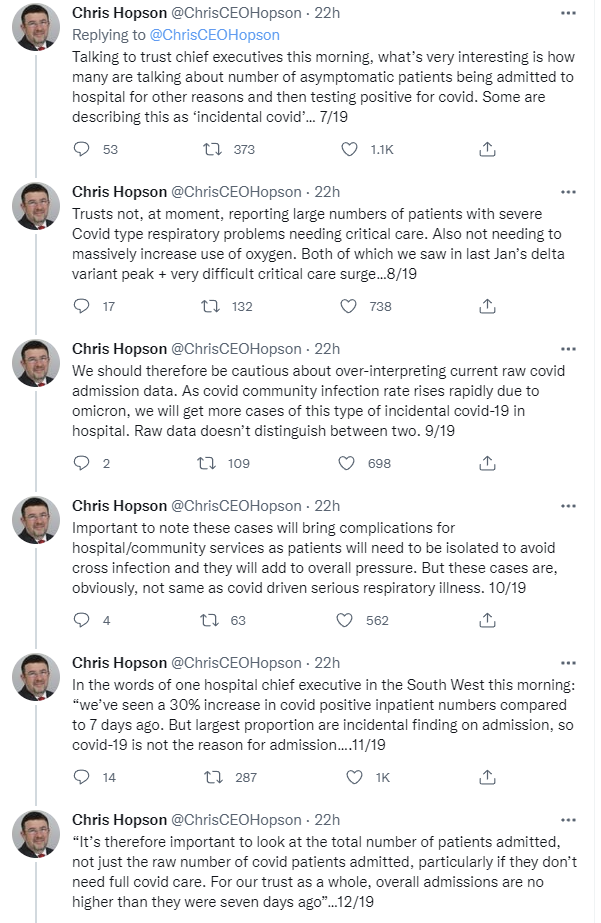

I find #12 especially interesting here: We don’t know which patients are in the hospital because of Covid, and that’s what matters, so ideally we’d compare total admissions now and then, the same way we might measure net excess deaths. As long as there’s plenty of capacity, that seems right, but the obvious problem is that as hospitals fill up admission criteria changes, and once they’re full admission numbers are effectively a constant, so this metric breaks down rapidly under strain. But if overall numbers haven’t changed at all, and there was capacity before, that seems like a big game. Then again, #15 notes that NHS was already under tremendous pressure. If anyone reading this works at a UK hospital, especially in London, I’d ask, if you know: Are the thresholds for admission starting to rise? Or are you using the same heuristics you were last month? And are the staff shortages pushing down ability to admit patients and reducing admissions that way?
So we can’t draw firm conclusions, as Hopson notes, but it’s still promising news. It certainly seems at this point to rule out relatively horrible outcomes on severity. By this point we would know.
Around the World
Washington State at 95% Omicron several days ago. So far, hospitalizations are rising much slower than cases, but lag makes it hard to know yet.
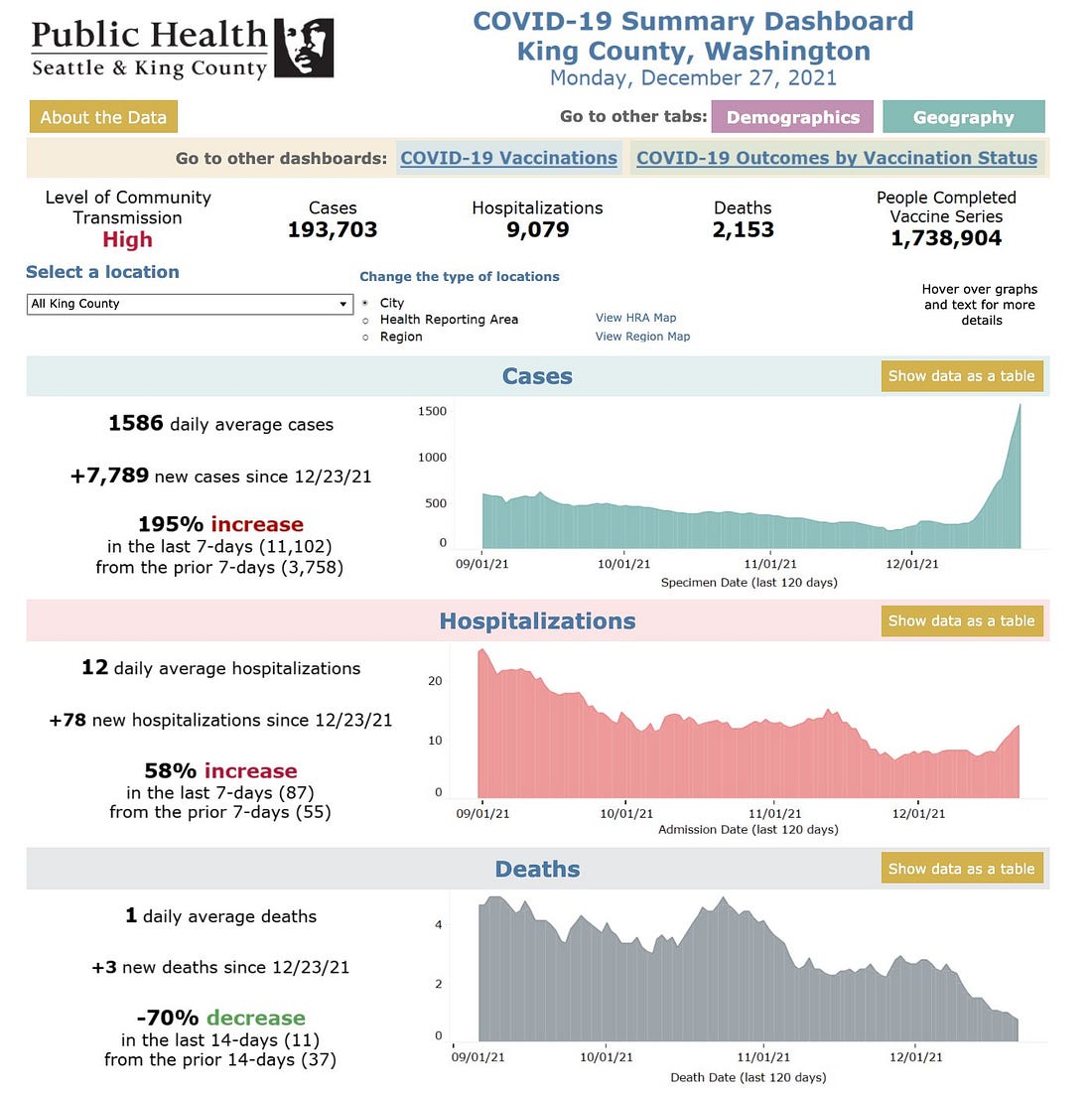
Rolling Stone assumes New York City is going to be okay because of high vaccination rates, but worries others won’t be because of lower rates, because the universe to such folks is a morality tale. New York needs its stronger prevention methods because it is naturally a much riskier place to be in a pandemic than most other places, the same way London is.
New York’s case count set another record over the weekend by a wide margin, even dividing the two-day report over two days. So far it’s not translating into a crisis, and at current rates things will be over fairly soon, but it’s a rather scary place to be.
Germany seems to be stopping Omicron in its tracks. Hospital admissions are down and cases are also down. I notice I am confused here. Germany’s rate of improvement under Delta wasn’t that rapid, so it shouldn’t have been sufficient for Omicron beyond slowing things down somewhat.
Nowcast Update
When the CDC came out with its nowcast update last week saying Omicron was 73% of cases and 95% of some areas, I noticed I was confused, eventually devoting a post to the question. I concluded that the nowcast was on the fritz, its model unable to handle the out-of-sample conditions being presented to it, and it was spouting out obvious nonsense that conflicted with many other data points.
It looks like that was correct, given the huge revisions we see this week. 73% is now 22.5% (!) and even this past week they only have us at 58.6%.
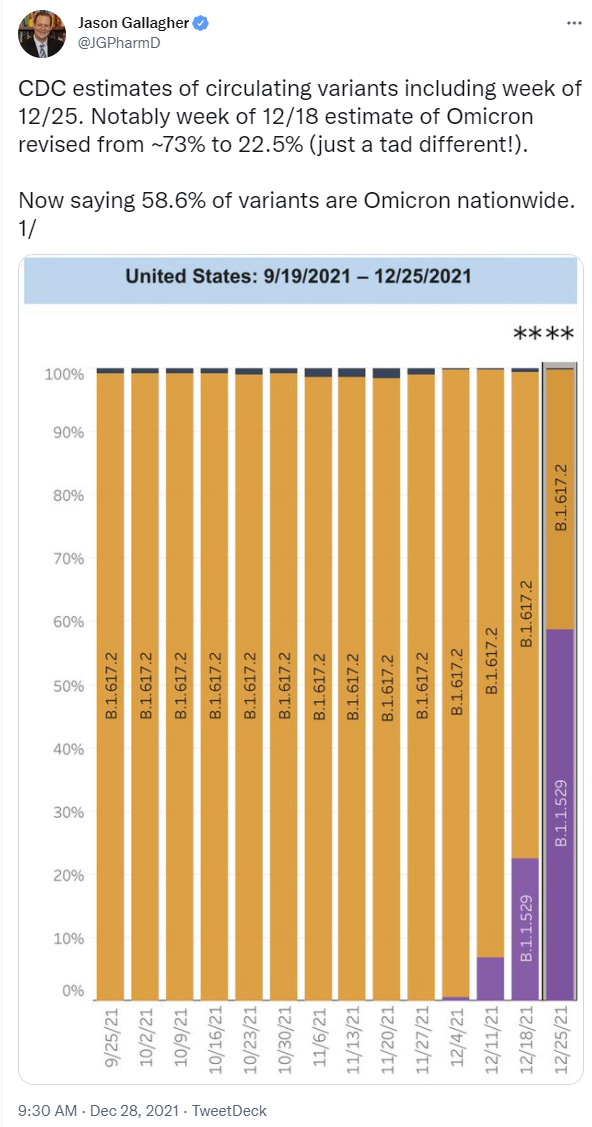
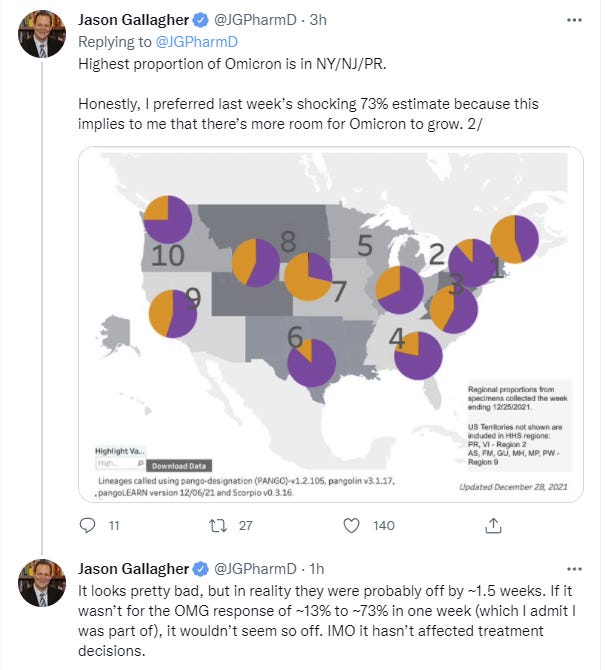
Agreed that little actual damage got done, treatment wasn’t impacted and mostly people didn’t pay the 73% number much mind. The new numbers are more reasonable, but seem low. We should expect a more rapid takeover than this, given large penetration in all geographical areas, so I think Nate’s take here is correct.

It’s good and right to revise numbers and admit you’re wrong, and the error here isn’t as big as it looks because exponential growth makes fools of us all. Still. When things are moving rapidly, the CDC’s methodology extrapolates in ways that make it highly unreliable, and we’re better off ignoring it.
Severity
Japanese preprint (direct link) claiming that Omicron has reduced binding potential to the lungs, and it is likely more transmissible but less pathogenic.
Abstract
The emergence of a new severe acute respiratory syndrome coronavirus 2
(SARS-CoV-2) variant, Omicron, is the most urgent concern in the global
health in December 2021 (ref.1). Our statistical modelling estimates that
Omicron is >3.0-fold and >5.6-fold more transmissible than Delta in South
Africa and the UK, respectively. Intriguingly, cell culture experiments show
that Omicron is less fusogenic than Delta and ancestral SARS-CoV-2.
Although the spike (S) protein of Delta is efficiently cleaved into the two
subunits, which facilitates cell-cell fusion2, Omicron S is faintly cleaved.
Further, in hamster model, Omicron poorly infects and spreads in the lung
and is less pathogenic compared to Delta and ancestral SARS-CoV-2. Our
data suggest that the efficacy of SARS-CoV-2 S cleavage and viral
fusogenicity are closely associated with viral pathogenicity, and Omicron
evolved to exhibit increased transmissibility and attenuated pathogenicity.
I’m insufficiently knowledgeable to evaluate these claims easily, but this isn’t the first result of this type, or the first similar interpretation.
Spread
South Korean study from 25 December estimates serial interval (generation time) of Omicron in South Korea at 2.2 days (!) +/- 1.62 days with R0 = 1.6. With that low a generation time 1.6 is still going to add up mighty fast. Note that 2.2 days is mind-blowingly low. If that’s a mean, then it implies that most of the spread is within four days of exposure. By contrast, a similar study of Delta found 3.3 days as the generation time, which is also much faster than the standard assumption of 5 days.
This isn’t a big enough sample to gain too much confidence, but it’s additional evidence in favor of shorter generation times.
The study also notes that 31% of cases at the church where the incident took place were double-vaccinated people, whereas 80% of the Korean population is double vaccinated, but they did not check for vaccination status at the church overall, which could easily have had a lower vaccination rate, so I wouldn’t read much into that.
I’ve heard of the CDC and similar government statements being overly conservative, but this seems rather ridiculous.

But the CDC said “scenarios with lower immune evasion” predict that the surge “could be lower and begin as late as April 2022.”
The report was updated on December 20. Here’s their ‘scenarios:’
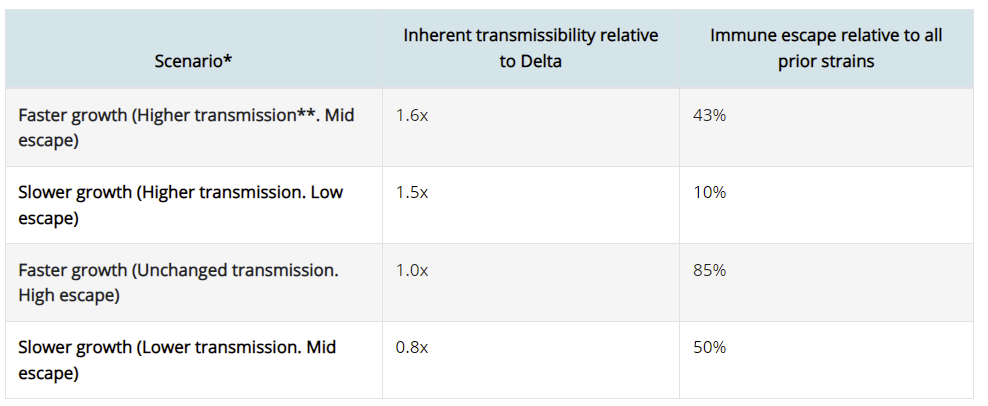
Yeah, none of these are plausible scenarios, or were plausible on December 20th.
Threads and Posts
Noah Smith Christmas Omicron Update. Reaches similar conclusions to post #9.
Stat News overview, and I have to admire the headline.

Always curious is where they try to take an exponential and make it linear somehow, without doing the math I’d think you had to do. In this case it’s here.
The newest variant has also inexorably altered the course of the pandemic. Although it’s still unclear how high and how fast the curves will climb (and how many people will get very sick or die in the process), Murray said when he and his team run their models further out, they see Covid-19 quieting down for much of 2022. “The thing Omicron will do, because it’s going to infect 40% of the entire world in the next two months, is it will raise population-wide immunity for a while,” he said. After a massive Omicron wave passes through, transmission should drop to very low levels. Ongoing rollouts of vaccines should help keep it that way.
Numbers like the 40% here always make me wonder, and I’m always sad to see people feel the need to say ‘for a while’ after such statements. Why should it stop at 40%? Why would 40% be sufficient to drop transmission to ‘very low levels’ given what we know?
There’s also the usual raising of possibilities that have already been mostly ruled out, but overall it’s not bad, better than expected.
For what the rhetorical case for panic looks like, 23 December thread from Yaneer Bar-Yam claiming high severity. Uses the ‘but Long Covid’ move and the ‘children are dying’ move based on reports of 21 deaths, which he says is a 3.5x increase and 3% of deaths (the discussion that follows involved a bunch of questioning of that claim and its source), calls for ‘protecting kids’ and ‘everyone’ from Omicron as if that is a thing that one could do. Even if fully accurate and representative (I have my doubts), that’s still 3% of deaths in kids that make up 34% of South Africa’s population, and that are presumably almost entirely unvaccinated, and out of a much reduced number of deaths versus previous waves. It’s clear he, like many others, interprets ‘severity’ as ‘the thing we want people to think is high.’
Trevor Bredford thread from 23 December viewing London as having peaked, with a (corrected) estimate of 10% of Londoners having had Omicron so far, or about triple the official number. I find that implausibly low, especially if the peak was real.
This thread from Farzad Mostashari estimates that about 3% or fewer of NYC Omicron patients likely end up needing hospitalization, which makes sense to me, in fact I think this underestimates case counts quite a bit and it’s even lower than that. Where I get confused is where suddenly he says this:

It would be profoundly surprising to have only a 15% or so infection rate for Omicron, especially given other ways of doing estimates, such as the situation where NYC faces a shortage of EMS crews.
Roughly 19% of the city’s more than 4,000 EMS workers were out sick Saturday, Christmas day, up from the typical rate of about 5%, an FDNY spokesman said.
The shortage — caused in part by crews isolating with COVID-19 cases — comes as the city’s daily number of cases continued a record breaking streak.
The question is, is that 19% of workers who were themselves sick or was that 19% who were sick or isolating due to exposure? As written it’s the first one, and it suggests a 14% rate of Covid infection, many times the citywide officially reported rate. I am inclined to believe the 14% rate, and to use it as a baseline for where things are in NYC. The 5% ‘normal’ rate seems higher than the usual baseline for sick days, and also presumably people are calling in sick with other non-Covid things more aggressively on the margin, but then again surely some people don’t notice they’re positive or power through it, so it’s not obvious the right direction to adjust this.
Certainly 15% already having gotten Omicron seems more plausible than 15% being the stopping point after six weeks. We’re already seeing official tallies of 0.3%/day, which is almost 15% found cases after six weeks of that, and that somehow assumes no further doublings.
Other News
Confirmation that Omicron infection protects against Delta. I wasn’t worried about this but it’s always good to have confirmation.
A lot of flights are getting cancelled, here’s one report of many. I had a visitor last night because his flight was delayed several times, leaving him time to come into the city, and he had to ultimately leave at 2:30am.
As a reminder, it’s quite the outlier, Omicron really does have a huge number of mutations.
Josh Barro points us to CDC statistics on infections on cruise ships, he says that a majority of ships reporting infections is new. My understanding was that for a while every cruise ship was automatically Covid-infected, and thus we stopped having cruise ships, but that wasn’t based on much data. Can I also ask, what the hell is up with this scale’s color scheme:
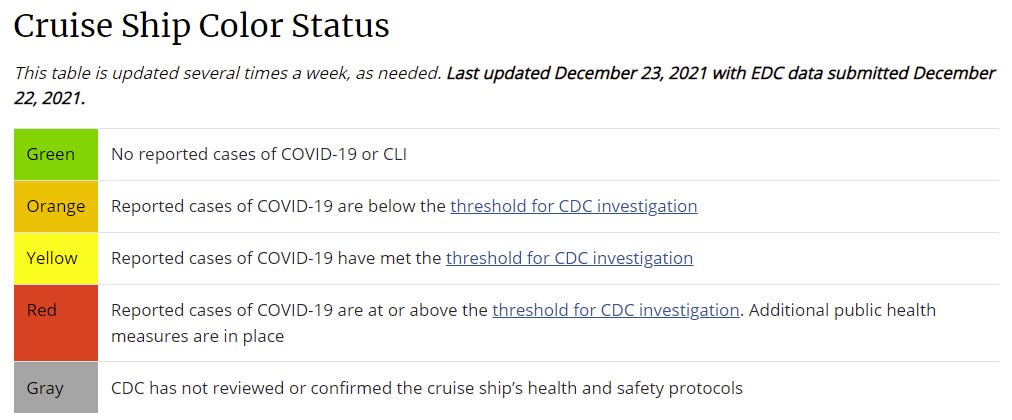
The majority are indeed in yellow, with some in green, and only a handful are orange. Having only a few Omicron cases isn’t a thing. I’d be curious to compare to past patterns, but it’s not obvious how to do that. Also, despite dozens of ships in yellow with ongoing investigations, zero ships currently are in red, meaning no one has ‘additional health measures in place.’
To what extent do you think the Chinese know this ‘disinfecting’ is the Goggles, and does nothing, but are doing it anyway? And to what extent do they actually think it matters? And to what extent is it a way to ensure people stay home?
Probability Updates
Chance that Omicron has a 100% or bigger transmission advantage in practice versus Delta: 70% → 65%.
The South Korean study points again to very short generation times, but with wide error bars. If it’s on the lower end, then we’re not going to hit the 100% threshold here. Warning flag that I may be under-updating here.
Chance that Omicron is importantly (25%+ in the same person) less virulent than Delta: 75% → 80%.
Chance that Omicron is vastly (75%+ in the same person) less virulent than Delta: 15% → 20%.
The data from London and elsewhere, and the general lack of bad news on such fronts, should make us more optimistic. Most cases being incidental is happening again.
Will the CDC label Omicron a variant of high consequence before 2022? 5% → 1.5%.
We’re out of time, and nothing happens this late in the year. Delisting unless it happens.
Chance we will be getting boosters modified for Omicron within 6 months of our previous booster shot: 25% → 25%.
No developments here, and time passing shouldn’t change things much.
Chance we are broadly looking at a future crisis situation with widely overwhelmed American hospitals, new large American lockdowns and things like that: 20% → 15%.
The longer things mostly hold up, the less likely this becomes. We’re getting closer to being in the clear.
Generation time (serial interval) of Omicron is 3.5 days or less: 75% → 85%
The South Korean study seems like strong evidence in favor of this.

>>Trevor Bredford thread from 23 December viewing London as having peaked, with a (corrected) estimate of 10% of Londoners having had Omicron so far, or about triple the official number. I find that implausibly low, especially if the peak was real.
Heterogeneous social contacts, my friend. Heterogeneous social contacts.
I posted this in #9 and it got buried, but may be an interesting practical exercise for y’all, applying these lessons to the blue-collar world. Anyway, I have a rapid testing program in place at my business, which involves a few dozen employees with close contact between each other and the public that can’t be easily mitigated, in an industry that’s too important to shut down in the old 2020 “abundance of caution” style. So far rapid tests have caught our few cases very early and prevented further exposure. Two areas of uncertainty I’m trying to figure out on the fly…
1) I saw some reports and literature that saliva/throat swabs turn positive somewhat faster than nasal swabs, and if that makes rapid tests even a few hours more sensitive that’s a huge win. On the other hand, the usual CYA and doing things by the book concerns, which don’t carry much weight for me.
2) With so much uncertainty about Omicron generation times, what sort of infectious pre-symptomatic window and typical infection/infectious/symptomatic timeline can we expect? I’ve already switched from every-other-day to daily testing, plus more for anyone isolating with possibly non-covid symptoms, but nasal swabs aren’t giving positive results until very close to symptom onset, which anecdotally seems to be 72-96 hours after exposure (if identifiable). It would be great if someone did a study tracking PCR Ct values every few hours for both nose and throat swabs against rapid test results specifically for vaccinated Omicron cases, as that would inform how far back to look at potential exposures and so on. I’m confident that rapid tests are catching the most infectious immediately pre-symptomatic window just fine, but I don’t know what they’re missing at the lower-probability early end.
More generally, given an ample but not infinite supply of Abbot tests, what sort of testing and isolation protocol will minimize employees getting sick at work without wasting too much of anyone’s time? It seems like the various windows and timelines suggested by the public health people are way out of date now.
Yeah, as usual experimentation illegal so we don’t have the info. I’d say go to every day (if testing supplies allow it) for tests if you care, and also look into P100+ super-masking to extent it’s possible under your social conditions. But basically from exposure you have 1-2 days most of the time and by the time you see symptoms, it’s largely too late.
If people get sick, I’d suggest two negative rapid tests 24 hours apart to come back, with no fixed number of days, if it were up to me.
My next post is planned to be about the CDC’s new guidelines, right now I am pausing for breath.
We can’t practically get any more mask/distance protection than we already have (communicating in respirators with background equipment noise is hard, customers need to hear us, various other practical issues with our environment) so going to daily rapid testing is the last dakka we have practically available, which we’ve just started. We can get enough tests to maintain this through the Omicron peak, at least.
I’m experimenting, though with hopefully small sample size, by having anyone with early symptoms do both throat and nasal tests to compare. Personally I’m doing throat and then nose with the same swab every time now, which is icky but maybe helpful?
The remaining hole in the daily testing plan is infections in the (hopefully very brief/nonexistent) window where there’s not yet enough virus in the right place for a positive rapid test, or that become infectious in the hours following a negative test. I don’t see any further low-hanging fruit there though. Testing only every other day, we’d certainly have some full heavy exposure days that could have been prevented.
Anecdotally we’ve had some cases with negative rapid test even after symptom onset, turning positive a few hours later, but I don’t know how that correlates with actual infectiousness, and my own sample size is tiny. I really want more data here for interpreting how much safety negative tests are buying us.
Current rules in my part of the world are still 10 days minimum isolation since symptom onset + 24 hours symptom-free. We do have generous sick leave so there’s no economic pressure to get back to work. We’re going to put that negative rapid test requirement before return in place though.
Thanks so much for your important work so far, Zvi!
“Another estimate has 9.5% of Londoners Covid-19 positive on Christmas Eve, which seems plausible to me.” The graph embedded here shows 9.5 per 1,000; or 0.95%.
Oh, Huh. So it does…
Upon quick investigation the y-axis label is wrong and the way everyone’s reading it is right. 9.5% makes sense in context of e.g. rest of thread, 0.95% would have London lower than other areas of England, which isn’t possible.
Just to confirm, the author of the post also confirmed this (https://mobile.twitter.com/john_actuary/status/1474418553545756694), and the excel sheet available from OSN (https://www.ons.gov.uk/peoplepopulationandcommunity/healthandsocialcare/conditionsanddiseases/datasets/coronaviruscovid19infectionsurveydata) also directly gives the percentage as 9.50%
Concerning Germany, I think the Omicron wave has been delayed by 1-2 weeks compared to other European countries. It’s also rising fast, but slower than elsewhere. Since Omicron is not yet dominant, the rise is hidden beneath Delta infections. This is seen in official PCR sequencing statistics, alas with 1-2 weeks of delay:
https://www.rki.de/DE/Content/InfAZ/N/Neuartiges_Coronavirus/Situationsberichte/Omikron-Faelle/Omikron-Faelle.html?__blob=publicationFile.
My top candidates for the reason why the increase is slower than elsewhere:
1) Masks are quite ubiquitous. In public transport, surgical masks or higher are mandatory, and compliance is high. Surgical masks (and FFP2 masks) are also common elsewhere. Other than cloth masks, they offer some real protection from the wearer.
2) Germany has just broken a severe Delta wave, much more severe than in most other European countries. Individual reactions to that are still lingering, and people are rather cautious.
In general, compliance and personal adaptation is much weaker in unvaccinated people (which form a larger minority than in many other European countries). So it makes sense that mask-wearing and personal risk adaptation has a relatively stronger impact on Omicron (where spread in vaccinated and compliant people is the main driver) than on Delta. Supporting fact: the infection rates among unvaccinated people were several times higher than among vaccinated people in the Delta wave.
Switzerland is similar: mask mandates in public transport and elsewhere, high compliance, a recent/ongoing Delta wave, and a large minority of unvaccinated people. No trace of Omicron was seen in the numbers until 24.12., so it was similarly puzzling. But all of a sudden, the numbers are now rising fast.
It seems to me that the true threat of Omicron is a vast increase in Long COVID, if its morbidity is at all similar to previous variants. If we assume COVID continues mutating to reinfect people, then the cumulative risk of becoming disabled or having >=moderate organ damage over a decade becomes quite high. This has profound implications for our civilization, a big one being that cities would become quite unhealthy places to live in. Another implication is that a large % of the population could become permanently disabled. Yet another is permanently reduced lifespans, as T-cell exhaustion means that older cohorts are unable to effectively fight reinfections and succumb to COVID.
The oft-repeated bluecheck meme that viruses tend to abate or become ‘less severe’ over time is patently false. Smallpox, rabies, and HIV would like to have a word with anyone who believes that.
Antivirals and well-crafted polyvalent vaccines may save us. We’ll see. I would be quite wary of taking Paxlovid prophylatically, though. It’s a protease inhibitor, and protease inhibitors can have quite severe/nasty side effects (https://en.wikipedia.org/wiki/Protease_inhibitor_(pharmacology)#Side_effects).
>>The oft-repeated bluecheck meme that viruses tend to abate or become ‘less severe’ over time is patently false. Smallpox, rabies, and HIV would like to have a word with anyone who believes that.
Yes, this is a myth in evolutionary terms, but it’s not a myth that viruses can become *effectively* less severe when the populace is no longer immunologically naive. See: https://cspicenter.org/blog/waronscience/why-covid-19-is-here-to-stay-and-why-you-shouldnt-worry-about-it/
Also, if long Covid were really such a big thing, wouldn’t we be seeing mass amounts of new disabilities in African countries, India, etc where a huge fraction of the population has been infected? Are 5% of Indian people newly disabled now? I feel like that would be in the headlines if it were true.
That is indeed true re: effective severity. However, coronaviruses are quite effective at mutating to defeat immunity – it’s why people on average get re-infected with the common cold every 2-3 years.
Data on India is quite sparse. However, there was an article in the Washington Post a few weeks ago about Long COVID in the US: https://www.washingtonpost.com/business/2021/12/09/long-covid-work-unemployed/
This is the key quote:
“Hard data is not available and estimates vary widely, but based on published studies and their own experience treating patients, several medical specialists said 750,000 to 1.3 million patients likely remain so sick for extended periods that they can’t return to the workforce full time.”
The problem here is that people in the US are immersed in media discussion of long covid. If you develop fibromyalgia or chronic fatigue for whatever reason, and like most people you have had covid at some point, what are you going to think was the cause?
The fact that we aren’t hearing about it from countries where even more people have had covid, but where they aren’t being primed as much to expect long covid, seems revealing to me.
Also of course there are all these large studies showing that anosmia is the only long term symptom actually correlated with positive serological tests.
Unlikely to happen, because Long COVID mostly doesn’t exist. Like Zvi said, all infectious disease cause long-lasting sequelae in a small number of cases, and COVID doesn’t seem to be especially severe in this regard. Everyone having gotten COVID will cause approximately the same number of permanent problems as the pre-existing fact that almost everyone has gotten the cold at some point in their life.
Long COVID definitely exists – there are numerous studies comparing COVID survivor morbidity vs population background rates and morbidity for other viruses. The reason the condition is so amorphous/poorly defined is because COVID binds to ACE2 receptors, which are prevalent all throughout the body. COVID can mess you up in a million different ways. It’s akin to taking chaos damage in an RPG.
Here’s a start: https://pubmed.ncbi.nlm.nih.gov/33532785/
Granted, the rates of Long COVID are definitely much lower than the popularly quoted 20-50%. ZOE data from the UK tracker app shows that people reporting symptoms lasting >12 weeks are 2-5% of all symptomatic cases.
The million dollar question: is repeated COVID infection every year akin to playing multiple games of Russian Disability Roulette with a 40-barreled revolver?
Denmark’s SSI is still producing it’s variant report on a daily basis: https://covid19.ssi.dk/virusvarianter/delta-pcr
Same for the numbers on their Covid-19 dashboard. I notice a dip in positive tests around Christmas, but the positive rate is still trending up.
Summary of a recent German study on long covid:
My main impression is that the uninfected (control group) have the same rate of long term symptoms as those Covid cases who were not diagnosed at the time of infection, but only discovered much later through antibody tests. The diagnosed Covid cases present only a slightly higher rate. We’ve seen something similar in previous long Covid studies that were, crucially, designed with these three groups for comparison. Considering that the media–in America and Europe–has pushed worries about long Covid almost since the beginning, it wouldn’t be surprising if the power of heavily repeated suggestion caused misattribution of illness or even induced a psychosomatic reaction in a few percent. Most people still think the media has informational authority. Long Covid lingers as a major issue: even if rare as an organic phenomenon, tens of millions believe themselves victims. Also: it seems possible that rates of long Covid may vary depending on the variant. But, especially with something like Omicron–with its speed and its many mutations–we won’t know until it’s too late.
> “Germany’s rate of improvement under Delta wasn’t that rapid, so it shouldn’t have been sufficient for Omicron beyond slowing things down somewhat.”
The generation times are even shorter than the 2 days median estimate, thus any useful prevention is even more disproportionately effective against omicron?
Regarding Israel cancelling 4th dose availability: is there a good reason why states don’t let people just get however many shots they ask for? Even the non-death non-long-covid symptoms (for middle-aged, perhaps expected 0.1 days of feeling terrible?) overwhelmingly justify the cost of a few dollars of the 4th jab that a meaningful number of people might ask for, assuming that its protection against each layer of severity continues to stack up straightforwardly. Separately, it might get people to calm down about the topic in general via standard heuristics (“if it’s not scarce/gatekept, surely it’s worthless” and “a known solution exists, might as well stop worrying about the problem”). That because folly behaves according to power laws, and thus a few crazies will ask for a dozen jabs, shouldn’t be relevant.
No, except that they’re constantly telling people what they must and can’t do in such spots, why change now?
I work at a large teaching hospital in the UK, but outside London. I’ve been isolating for a while (very mild if any symptoms, but was undergoing regular testing at work). Prior to my isolation, there were rising numbers, but they were still using respiratory beds for ‘Incidental covid’ types. Anecdotal observation supported the idea that staff isolation and the need to isolate from vulnerable covid-negatives was more of a challenge at that point than any influx of very unwell covid pneumonitis types.
I’ll aim to update when I’m next in work.
I’m back in work now. There’s a small uptick in actual respiratory admissions but most of the increased covid capacity the hospital has put together is being filled by geriatrics patients who happen to have covid. A friend who works at a nearby hospital reports that she has about a quarter of her unit in self isolation for one reason or other.
It’s actually remarkable how few people are coming in with fevers and breathlessness.
Thanks! Keep us posted.
I’ve created a new Metaculus question on when quarantine-free travel to China will be possible, which I *think* is essentially a proxy question for “when the pandemic will be over”: https://www.metaculus.com/questions/9038/quarantine-free-us-travel-to-china/. Curious to see the predictions when the question opens.
Will try to see if the real-money crypto prediction markets would be interested in adding this too.
It’s a question of when China gives up on containment, which might not correspond well (in either direction) for various reasons, but it’s an interesting question!
I got covid about 1.5 weeks ago and seems to have noticeably worsened my otherwise low grade depression. It probably a combination of the drawn out fatigue, quarantine isolation (especially around holidays), and ironically not drinking alcohol (usually gives me something to look forward to in evening). I haven’t seen this talked about much but wonder what indirect toll this is taking on a population that’s already been through a lot this past year or so.
Seeing the 9.5% COVID prevalence in London (19th Dec) I was wondering can anyone from London tell if >~10% of their friends have COVID? Shouldn’t we see large problems with workers isolating due to symptoms or contacts?
PS: Looking at these data, my comment on the last post hopping for a sooner peak definitely turned out to be too optimistic, and Zvi’s scepticism right.
Pingback: Covid 12/30: Infinity War | Don't Worry About the Vase
Pingback: Omicron Post #11 | Don't Worry About the Vase
> Another estimate has 9.5% of Londoners Covid-19 positive on Christmas Eve, which seems plausible to me. (EDIT: I believe that the y-axis is labeled in error, and this is indeed 9.5% rather than 0.95%. If it is 0.95%, I defy the data, that number doesn’t make sense.)
Why doesn’t it make sense?
This article (https://www.independent.co.uk/news/uk/home-news/covid-uk-cases-today-latest-b1982099.html) is from a few days ago, talking about a record-breaking 122k daily covid cases, which is about 0.18% (18/1000) of their population. If it quadrupled since then, that’d be about 0.95%. The graph doesn’t say “number of people infected on a given day”, it says “Infection Rates”, so it makes sense to me. Seems like the only incorrect thing is interpreting it as the number of infected people existing each day (much larger, since covid lasts >1 day), versus the number of people infected per day.
> Another estimate has 9.5% of Londoners Covid-19 positive on Christmas Eve, which seems plausible to me. (EDIT: I believe that the y-axis is labeled in error, and this is indeed 9.5% rather than 0.95%. If it is 0.95%, I defy the data, that number doesn’t make sense.)
Why doesn’t it make sense?
This article (https://www.independent.co.uk/news/uk/home-news/covid-uk-cases-today-latest-b1982099.html) is from a few days ago, talking about a record-breaking 122k daily covid cases, which is about 0.18% (18/1000) of their population. If it quadrupled since then, that’d be about 0.95%. The graph doesn’t say “number of people who are positive on a given day”, it says “Infection Rates”, so it makes sense to me. Seems like the only incorrect thing is interpreting it as the number of infected people existing each day (much larger, since covid lasts >1 day), versus the number of people infected per day.
Reply
In addition to the confusion over what’s measured, I’d claim that ‘most cases are being identified’ is not something that is plausible at this time.
Oh, definitely agree :). People should specify if they’re referring to new identified cases per day vs total expected new cases per day including people who won’t get tested.